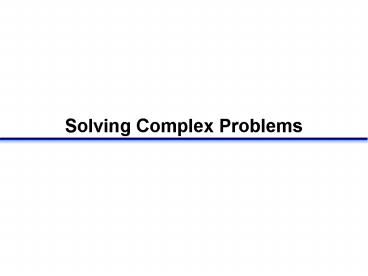Solving Complex Problems - PowerPoint PPT Presentation
Title:
Solving Complex Problems
Description:
Solving Complex Problems Review A subroutine is a set of instructions to perform a particular computation used to solve subproblems of more complex problems used for ... – PowerPoint PPT presentation
Number of Views:286
Avg rating:3.0/5.0
Title: Solving Complex Problems
1
Solving Complex Problems
2
Review
- A subroutine is a set of instructions to perform
a particular computation - used to solve subproblems of more complex
problems - used for computations performed more than once in
a single program or that are required in many
different programs - you only need to write it once
- Subroutines have names, zero or more parameters,
return types, and a body of statements that
perform the actual computations
3
Syntax
- The return-type specifies the data type of the
output - The parameter-list is a comma-separated list of
the input variables and their types - each list item has the form input-type
variable-name - A program refers to the subroutine by
subroutine-name - The body consists of the statements between
return-type subroutine-name( parameter-list )
statements
4
Add two integers
int add(int x, int y) return xy
5
Minimum of two integers
int minimum(int x, int y) if(x lt y)
return x else return y
6
Sum of positive integers
int sum_integers(int n) int k int
sum0 for(k1 kltn k)
sumsumk return sum
7
Factorial
int factorial(int n) int k int fn1
for(k2 kltn k) fnfnk
return fn
8
What about harder problems?
- Examples so far add, minimum, sum, factorial
- straightforward computation
- small number of intermediate variables
- single control structure
- How do we design algorithms for more complicated
problems? - complex computation
- many intermediate variables
- multiple control structures
- Often difficult to visualize all the details of a
complete solution to a problem
9
Top-down design
- Top-down design
- original problem is divided into simpler
independent subproblems - successive refinement these subproblems may
require further division into smaller subproblems - continue until all subproblems can be easily
solved or you already have a method to solve them
10
Solving complex problems
- Divide complex problem into subproblems
- For each subproblem
- analyze the problem
- do we already have a subroutine to solve it?
- can we easily design an algorithm to solve it?
- can it be divided further?
- solve the problem
- Combine solutions of all subproblems to solve the
original problem
11
Minimum of three integers
- Problem Find the minimum of three integers
12
Minimum of three integers
- Analyze the problem
- Inputs
- x first integer
- y second integer
- z third integer
- Output
- min_xyz minimum of x, y and z
- How do we find the minimum?
- we already have a subroutine to find the minimum
of two integers
13
Top-down design
Compute minimum of x, y, and z
Compute minimum of x and y
Compute minimum of solution toSUBPROBLEM1 and z
SUBPROBLEM1
SUBPROBLEM2
14
Calling subroutines
- A subroutine call statement has the following
syntax - subroutine-name( parameters )
- Calling a subroutine executes the statements in
the body of the called subroutine using the
specified parameters - parameters is a comma-separated list of input
values - the input values must be of the same type as
those in the subroutines parameter list - The subroutine call statement may be part of an
assignment statement or an return statement
15
Minimum of three integers
- We can call our minimum subroutine twice to
compute the minimum of three integers - int min_xy, min_xyz
- min_xy minimum(x,y)
- min_xyz minimum(min_xy,z)
16
Minimum of three integers - subroutine
int min3(int x, int y, int z) int min_xy,
min_xyz min_xy minimum(x,y) min_xyz
minimum(min_xy,z) return min_xyz
17
Combination
Problem Compute C(n,k)
18
Definition combination
- A combination C(n,k) is the number of ways to
select a group of k objects from a population of
n distinct objects - where n! is the factorial function
- n! n(n1)(n-2) 321
19
Top-down design
Compute k!
Compute n!
Compute (n-k)!
SUBPROBLEM3
SUBPROBLEM2
SUBPROBLEM1
20
Combination - subroutine
- We can call our factorial subroutine three times
to compute C(n,k)
int combination(int n, int k) return
factorial(n)/ (factorial(k)factorial(n-k)
)
21
Exercises
- We have a subroutine sum_integers that computes
the sum of the first n positive integersWrite a
subroutine named sum_between to compute the
inclusive sum between two integers by making two
calls to sum_integers - Write a subroutine named min4 to compute the
minimum of four numbers































